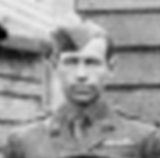confirmed
Born: 13 July 1895
Died: 4 October 1971
Enlisted as Sapper, 8 August 1914, in the 1st Field Company, and sailed from Sydney with the 1st AIF on 18 October 1914 (SS Afric).
Served in Egypt with the 1st Division from December 1914 to February 1915.
Landed at Anzac with the 1st Field Engineers, 25 April 1915.
Evacuated from Gallipoli December 1915 after seven months service there.
Recommended for award -
His work in the trenches opposite German Officer's Trench under heavy fire repairing parapets was excellent and deserves much praise. He took part in the attack on German Officer's Trench and Sniper's Trench on 6th August and displayed much gallantry and has done good and consistent work since that date.
Transferred to the 14th Field Company at Tel-el-Kabir, Egypt, December 15th and spent six months there and at Suez Canal with the 5th Division.
July 1916 shipped to France with the 5th Division and served there as Sergeant of Engineers for 15 months.
Awarded the French Medaille Militaire (promulgated in Commonwealth of Australia Gazette, No. 169 of 4th October 1917).
Transferred to the Royal Flying Corps for 3 months and later to the Australian Flying Corps. Banks was an observer with 3 Squadron AFC.
On 21 April 1918, Banks played a part in the Red Baron's last flight.
Two No. 3 Squadron aircraft were instrumental in triggering-off the famous aerial combat of 21 April 1918 that resulted in the death of Germany's leading air ace, Baron Manfred von Richthofen. On that fateful Sunday morning, Lieutenants S. G. Garrett and A. V. Barrow (in A.3661) and Lieutenants T. L. Simpson and F. C. Banks (in B.6576) were on a reconnaissance of the German lines near Hamel at 7000 feet when they were attacked by an element of four Fokker DrI triplanes from a large 'Richthofen's Circus' formation, led by the Baron himself. Simpson and Banks fought their way to the safety of nearby cloud cover, and the enemy triplanes concentrated on the second R.E.8. Through a combination of Garrett's skilful flying and Barrow's accurate shooting, one triplane, believed to be a Jasta 5 machine, was shot down. The other three triplanes then withdrew to the main Circus formation to regroup for an approaching attack by several Sopwith Camels from No. 209 Squadron, Royal Air Force. It was during the subsequent fight that the 'Red Baron' was shot down fatally. [His body was subsequently buried with full military honours by 3 Squadron.]
Meanwhile, Simpson and Garrett had completed their photographic commitment and were on their way home at 8000 feet. But R.E.8 B.6576 had a further clash with a large formation of Albatros scouts, out to avenge the death of their leader, von Richthofen. Simpson took the only way out. He dove the R.E.8 towards the ground while Banks kept up a steady stream of machine-gun fire to ward off the attackers. Eventually they eluded their pursuers and flew home at 2000 feet.
In 1919, Banks trained in aircraft construction for 7 months with Handley Page Limited, Cricklewood, London.
Probably lived in Mosman immediately after the war, his Belmont Road address is noted on a document dating from 1920.
His father moved to Mosman in 1914 after he retired from 50 years teaching in the NSW Department of Education,
His first wife, Frances Ann Richards, whom he married in Ireland in 1918, died in 1927. He married Joyce Ruth Glover in 1931.
- Name recorded
- Service number
- Ranks
- Birth records
- Death record
- Life event
- Address
- Relationships
- Organisations
- Main sources
-
- Banks Edmond Clifford : SERN LIEUT 14 : POB Sydney NSW : POE Sydney NSW : NOK W Banks Frances Anne (item)
- Discovering Anzacs - Edmond Clifford Banks (webpage)
- Honours and Awards - Edmond Clifford Banks - Gallipoli (webpage)
- Honours and Awards - Edmond Clifford Banks - French Medaille Militaire (webpage)
- Lt Edmond Clifford Banks, observer (Group portrait of the Commanding Officer and Officers of No. 3 Squadron, Australian Flying Corps) (photograph)
